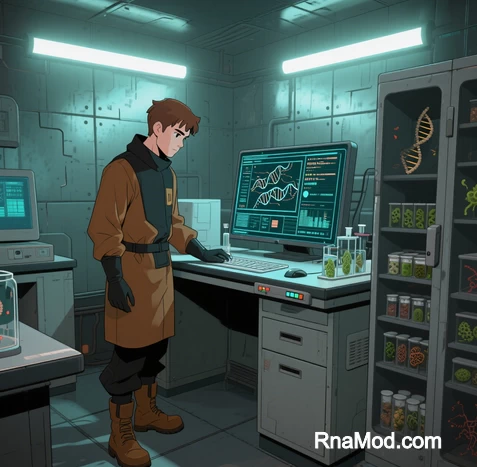 Transcription represents the foundational process by which genetic information encoded in DNA is converted into complementary RNA sequences. This enzymatic synthesis serves as the critical first step in gene expression, enabling cells to selectively utilize genomic instructions for protein synthesis, regulatory functions, and cellular adaptation. Below we delineate the core concepts governing this molecular process.
Transcription represents the foundational process by which genetic information encoded in DNA is converted into complementary RNA sequences. This enzymatic synthesis serves as the critical first step in gene expression, enabling cells to selectively utilize genomic instructions for protein synthesis, regulatory functions, and cellular adaptation. Below we delineate the core concepts governing this molecular process.
I. Foundational Framework
Transcription is the template-directed synthesis of RNA from a DNA sequence, catalyzed by RNA polymerase (RNAP). Unlike DNA replication, transcription:
- Produces single-stranded RNA molecules (mRNA, tRNA, rRNA)
- Targets specific gene regions rather than entire chromosomes
- Requires no primer for initiation
- Exhibits higher error tolerance (~10⁻⁴ error rate)
(Fig. 1: Transcription Workflow)
Description: DNA unwinds at a gene locus. RNAP (blue) synthesizes nascent RNA (red) complementary to the template strand. Transcription factors (yellow) regulate initiation at promoter regions.
II. The Transcription Cycle: Three Stages
A. Initiation: Precision Assembly
- Promoter Recognition:
- RNAP binds conserved DNA sequences (TATA box in eukaryotes; -10/-35 elements in bacteria)
- Transcription factors recruit RNAP and position it at the transcription start site
- Preinitiation Complex (PIC) Formation:
- Eukaryotes require assembly of general transcription factors (e.g., TFIID, TFIIB)
- DNA Melting:
- Helicase activity forms a 14-bp transcription bubble, exposing the template strand
B. Elongation: Processive RNA Synthesis
- Directionality: RNAP reads template DNA 3’→5’, synthesizing RNA 5’→3’
- Rate: 40-80 nucleotides/sec in eukaryotes
- Topological Management:
- Positive supercoils ahead resolved by topoisomerases
- Transient 8-9 bp RNA-DNA hybrid stabilizes elongation
(Fig. 2: Transcription Bubble Dynamics)
Description: RNAP encloses melted DNA. Nascent RNA hybridizes transiently with template strand. Supercoils accumulate ahead of the complex.
C. Termination: Programmed Cessation
| Mechanism | Key Features | Organisms |
|---|---|---|
| Rho-Dependent | Rho helicase disrupts RNA-DNA hybrid | Bacteria |
| Intrinsic Termination | GC-rich hairpin + poly-U tract stalls RNAP | Bacteria/Archaea |
| Poly(A)-Coupled | Endonuclease cleavage at poly(A) signal | Eukaryotes |
III. Key Molecular Components
A. RNA Polymerase (RNAP)
| Type | Transcribed RNAs | Function |
|---|---|---|
| Pol I | 18S/5.8S/28S rRNA | Ribosome assembly |
| Pol II | mRNA, snRNAs | Protein-coding instructions |
| Pol III | tRNA, 5S rRNA | Translation machinery |
B. Regulatory Elements
- Promoters: DNA sequences upstream of genes that recruit RNAP
- Enhancers: Distal regulatory elements that loop chromatin to activate promoters
- Silencers: Repressor-binding sites that block transcription
IV. Post-Transcriptional Processing
Critical modifications to primary RNA transcripts include:
- 5′ Capping:
- Addition of 7-methylguanosine to mRNA
- Enhances stability and translation efficiency
- 3′ Polyadenylation:
- Addition of 150-200 adenylate residues
- Facilitates nuclear export and stability
- Splicing:
- Removal of introns by spliceosome complexes
- Joining of exons to form mature mRNA
(Fig. 3: mRNA Processing Steps)
Description: Nascent mRNA undergoing 5′ capping, intron removal, and poly(A) tail addition.
V. Transcriptional Regulation
A. Epigenetic Control
- Histone Modifications: H3K4me3 (activation) vs. H3K27me3 (repression)
- DNA Methylation: Hypermethylation of CpG islands silences promoters
B. Directionality Principles
- Template strand is always read 3’→5’
- RNA synthesis occurs 5’→3’
- RNA sequence mirrors the non-template strand with T→U substitution
VI. Evolutionary Conservation
| Feature | Prokaryotes | Eukaryotes |
|---|---|---|
| RNAP Complexity | Single multi-subunit complex | Three specialized polymerases |
| Promoter Structure | -10 (TATAAT) / -35 elements | TATA box, BRE, DPE |
| Termination | Rho-dependent/Intrinsic | Poly(A)-coupled |
“Transcription is not molecular photocopying—it is the cell’s master control system for converting static genetic code into dynamic biological responses.”
— Molecular Biology Review
Data sourced from publicly available references. For collaboration inquiries, contact: chuanchuan810@gmail.com.
